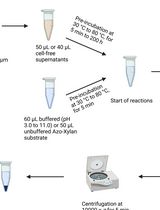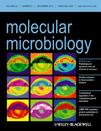- Submit a Protocol
- Receive Our Alerts
- Log in
- /
- Sign up
- My Bio Page
- Edit My Profile
- Change Password
- Log Out
- EN
- EN - English
- CN - 中文
- Protocols
- Articles and Issues
- For Authors
- About
- Become a Reviewer
- EN - English
- CN - 中文
- Home
- Protocols
- Articles and Issues
- For Authors
- About
- Become a Reviewer
Acetyl-coenzyme A Synthetase (Acs) Assay
Published: Vol 2, Iss 17, Sep 5, 2012 DOI: 10.21769/BioProtoc.256 Views: 17959

Protocol Collections
Comprehensive collections of detailed, peer-reviewed protocols focusing on specific topics
Related protocols

Endo-1,4-β-D-xylanase Assay Using Azo-Xylan and Variants Thereof
Luca Bombardi [...] Salvatore Fusco
Apr 20, 2025 1850 Views

Activation of X-Succinate Synthases for Fumarate Hydroalkylation Using an In Vitro Activation Method
Anshika Vats [...] Mary C. Andorfer
Jun 20, 2025 2428 Views

An Optimized Enzyme-Coupled Spectrophotometric Method for Measuring Pyruvate Kinase Kinetics
Saurabh Upadhyay
Aug 20, 2025 2300 Views
Abstract
Acetyl-coenzyme A synthethase (Acs, E.C.6.2.1.1) is an acetate activating enzyme widely represented in nature from bacteria to human. Its function is important for cellular catabolism, especially in order to support microbial growth at low concentrations of acetate (<10 mM) (Castano Cerezo et al., 2011; Castano Cerezo et al., 2009;Renilla et al., 2012). In this protocol, a continuous coupled enzymatic assay for Acs activity is described. Product formation is followed spectrophotometrically by the formation of NADH. The protocol is tailored for E. coli’s Acs, but it can be adapted to assay Acs in any other organism.
The acetyl-coenzyme A synthetase (Acs) assay was first described by Brown et al. (1977). Acs activity is measured using an enzymatic method coupled to malate dehydrogenase (Mdh) and citrate synthase (Cs):
(Acs) acetate + CoASH + ATP -> acetyl-CoA + AMP
(Cs) acetyl-CoA + oxaloacetate -> citrate + CoASH
(Mdh) L-malate + NAD+ -> oxaloacetate + NADH
Net reaction: Acetate + ATP + L-malate + NAD+ -> citrate + AMP + NADH
Under the assay conditions, Mdh and Cs activities are in excess and the rate of NADH formation is limited by Acs activity.
Materials and Reagents
- Extraction
- Potassium phosphate buffer 65 mM (pH 7.5) (Sigma-Aldrich, catalog number: P5379 )
- Cultured cells (approx. 1010 cells) (e.g., for Escherichia coli cells grown in M9 glucose minimal medium, 1 ml of OD600 1 corresponds to approx. 6 x 108 cells)
- Enzyme activity
- 100 mM Tris-HCl buffer (pH 7.8) (Sigma-Aldrich, catalog number: T1502 )
- 20 mM ATP (Sigma-Aldrich, catalog number: A3377 )
- 2 mM Coenzyme A trilithium salt (CoASH) (Sigma-Aldrich, catalog number: C3019 )
- 60 mM β-nicotinamide adenine dinucleotide hydrate (NAD+) (Sigma-Aldrich, catalog number: N7004 )
- 50 mM MgCl2 (Panreac Applichem, catalog number: 131396 )
- 50 mM L-malate (Sigma-Aldrich, catalog number: 02288 )
- 1 M sodium acetate trihydrate (Sigma-Aldrich, catalog number: S8625 )
- 50 U/ml malate dehydrogenase (Mdh) from bovine heart (Sigma-Aldrich, catalog number: M9004 )
- 25 U/ml citrate synthase from porcine heart (Cs) (Sigma-Aldrich, catalog number: C3260 )
Reagents 2-4 were prepared in milliQ water and components 5-7 in Tris-HCl buffer (100 mM, pH 7.8). All concentrated stocks (1-7) were prepared in advance and stored at -20 °C. Enzymes (8-9) were stored at 4-6 °C (following the instructions of the manufacturer) and diluted in Tris-HCl buffer (100 mM, pH 7.8) immediately before being used. - 96 well flat bottom, non-treated, non-sterile transpartent plates
- Ice-cold phosphate buffer
Equipment
- Refrigerated benchtop centrifuge (Eppendorf, catalog number: 5801 R )
- Ultrasonic homogenizer (Sonics & Materials Inc., Vibra Cell VC 375) equipped with a 3 mm diameter probe
- Spectrophotometric plate reader (Bio-Tek)
- Novaspec Plus spectrophotometer (Amersham Bioscience GE Healthcare Europe GmbH)
- Non-sterile transpartent plates
- Water-ice bath
Procedure
- Protein extraction procedure
- Harvest the cells at the phase of culture of interest, e.g. for E. coli, 50 ml of a culture in exponential growth phase (OD600=0.8) or 20 ml of a culture in stationary phase (OD600=2.0).
- Cool the cells in a water-ice bath for 1-2 min.
- Centrifuge the cells for 15 min (10,000 x g, 4 °C).
- Discard the supernatant.
- Resuspend the cells in ice-cold phosphate buffer (in order to ensure proper washing of cells, use the same initial volume of sample).
- Centrifuge the cells for 15 min (10,000 x g, 4 °C). Discard the supernatant.
Resuspend the cells in ice-cold phosphate buffer. Use an appropriate volume of buffer, calculated according to the following equation; this will result in a concentrated cell suspension of OD600 of 50:
ml (phosphate buffer)=(OD600 x Vol (ml culture volume))/50
Where OD600 is considered as readout of the concentration of cells in the sample (Castano-Cerezo et al., 2011). - Disrupt the cells using an ultrasonic homogenizer as follows. Transfer the cell suspension to a 1.5 ml conical tube and place it in an ice bucket. Subject the cell suspension to 3 sonication pulses (20 sec each, 21% amplitude, 3-mm diameter probe, 50% power input). Respect 60 sec intervals between sonication cycles in order to avoid over-heating of samples.
- Centrifuge the disrupted cells for 30 min (20,000 x g, 4 °C).
- Collect the supernatant (cell-free extract) and transfer it to a clean 1.5 ml conical tube. Inspect the cell-free extract for suspended particles. If necessary, centrifuge again.
- Use the cell- free extract immediately for acetyl-CoA synthetase assay or store the supernatant at -70 °C for long term use.
- Acetyl-coenzyme A synthethase assay
For proper determination of enzyme activity, the optimal dilution of the protein extract has to be determined for each sample, since the activity of extracted enzyme is influenced by the physiological state and the extraction yield of the cells.- Thaw the protein extracts and reagent stocks on ice. Dilute the Mdh and Cs enzyme stocks as explained in the Materials and Methods section and keep them on ice.
- Connect the plate reader and allow it to reach 37 °C.
- Prepare a "Master Mix" according to the number of samples to be analyzed. The "Master Mix" should contain all the reaction components except for sodium acetate (the substrate of Acs) and the protein extract. Remember to consider sample triplicates. Keep the "Master Mix" on ice.
"Master Mix" per reaction:
100 mM Tris-HCl buffer (pH 7.8): 70 μl
50 mM L-malate : 10 μl
20 mM ATP : 10 μl
50 mM MgCl2 : 10 μl
2 mM CoASH : 10 μl
60 mM NAD+ : 10 μl
50 U/ml Mdh : 10 μl
25 U/ml Cs : 10 μl - Prepare several dilutions of the protein extract in phosphate buffer. Choose dilutions in a wide enough range (e.g.: 1:1, 1:10, 1:100 and 1:1,000).
- In a 96 well flat bottom, transparent plate, add 140 μl of the Master Mix to each well.
- Add 40 μl of each of the protein dilutions. Pipet up and down in order to mix the reaction components properly. Tip: Avoid the formation of air bubbles.
- Start the reaction by adding 20 ul of 1 M sodium acetate into the sample and mix well by pipetting up and down.
- Incubate at 37 °C in the plate reader and record the continuous increase in absorbance at 340 nm (due to the reduction of NAD+) for 5-10 min. Recording should start immediately after starting the reaction. Adjust the reader to get an absorbance value each 10-20 sec.
- Calculate the maximum slope in the OD over time plot (ΔOD/min) for each dilution of the protein extract. For subsequent measurements, select the 2-3 dilutions of the extract to yield a ΔOD/min=10-200. If necessary, assay other dilutions (the typical optimal dilution for Acs activity in cell extracts of glucose-limited stationary phase cultures of E. coli extracts with a protein concentration of approx. 15 mg/ml is 1:20).
- Repeat steps 4-10 with the dilutions selected. Perform the assay, at least, in triplicate. To ensure proper determination of enzyme activity in the extract, ΔOD/min should be proportional to protein content.
- Calculate the Enzyme Activity Units for the protein extract assayed using the following equation:
Acs Activity (U/ml) = (ΔOD (/min)*Vr*Df) / (ε *l*Ve)
Where:
ΔOD (/min) = maximum slope in the OD vs. t plot (/min)
Vr = reaction volume (μl)
Df = dilution factor
ε NADH 340 nm = 6.22 ml*/μmol*/cm
l = optical path length (cm)a
Ve = protein extract volume (μl)b
aTo determine the optical path length, refer to the specifications of your 96 well plates to get the diameter of the well. Calculate the optical path length from the total liquid volume used in the assay and the diameter of the well.
bThis volume refers to the volume of diluted extract added to the assay. - Determine the protein concentration of the extracts assayed [e.g. using the Lowry (Hartree, 1972) or the Bicinchoninic Acid method (Smith et al., 1985)].
- Determine the specific Acs activity for each extract using the following equation:
Acs Specific Activity (U/mg) = Acs Activity (U/ml) / Protein concentration (mg/ml)
Recipes
- All the reagents, except for the Mdh and Cs dilution, can be prepared in advance and be stored at -20 °C for up to 1 year.
- All the reagents are prepared in 100 mM Tris-HCl buffer (pH 7.8) except for NAD+, CoASH and ATP that should be dissolved in MilliQ water.
- Potassium phosphate buffer (65 mM). Adjust pH to 7.5 with 1 M KOH.
- Tris-HCl buffer 100 mM. Adjust pH to 7.8 with 1 M KOH.
Acknowledgments
This protocol was first described in and adapted from Brown et al. (1977) and previously used in Castano-Cerezo et al. (2009) and Castano-Cerezo et al. (2011).
References
- Brown, T. D., Jones-Mortimer, M. C. and Kornberg, H. L. (1977). The enzymic interconversion of acetate and acetyl-coenzyme A in Escherichia coli. J Gen Microbiol 102(2): 327-336.
- Castano-Cerezo, S., Bernal, V., Blanco-Catala, J., Iborra, J. L. and Canovas, M. (2011). cAMP-CRP co-ordinates the expression of the protein acetylation pathway with central metabolism in Escherichia coli. Mol Microbiol 82(5): 1110-1128.
- Castano-Cerezo, S., Pastor, J. M., Renilla, S., Bernal, V., Iborra, J. L. and Canovas, M. (2009). An insight into the role of phosphotransacetylase (pta) and the acetate/acetyl-CoA node in Escherichia coli. Microb Cell Fact 8: 54.
- Hartree, E. F. (1972). Determination of protein: a modification of the Lowry method that gives a linear photometric response. Anal Biochem 48(2): 422-427.
- Renilla, S., Bernal, V., Fuhrer, T., Castano-Cerezo, S., Pastor, J. M., Iborra, J. L., Sauer, U. and Canovas, M. (2012). Acetate scavenging activity in Escherichia coli: interplay of acetyl-CoA synthetase and the PEP-glyoxylate cycle in chemostat cultures. Appl Microbiol Biotechnol 93(5): 2109-2124.
- Smith, P. K., Krohn, R. I., Hermanson, G. T., Mallia, A. K., Gartner, F. H., Provenzano, M. D., Fujimoto, E. K., Goeke, N. M., Olson, B. J. and Klenk, D. C. (1985). Measurement of protein using bicinchoninic acid. Anal Biochem 150(1): 76-85.
Article Information
Copyright
© 2012 The Authors; exclusive licensee Bio-protocol LLC.
How to cite
Castaño-Cerezo, S., Bernal, V. and Cánovas, M. (2012). Acetyl-coenzyme A Synthetase (Acs) Assay. Bio-protocol 2(17): e256. DOI: 10.21769/BioProtoc.256.
Category
Biochemistry > Protein > Activity
Do you have any questions about this protocol?
Post your question to gather feedback from the community. We will also invite the authors of this article to respond.
Share
Bluesky
X
Copy link











